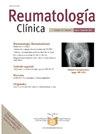心理社会因素能预测纤维肌痛综合征的病情严重程度吗?
IF 1.2
Q4 RHEUMATOLOGY
引用次数: 0
摘要
目的本研究旨在探讨纤维肌痛综合征(FMS)患者的焦虑、抑郁、疼痛集中和疼痛灾难化,并评估这些因素是否为FMS疾病严重程度的预测因素。患者和方法采用贝克抑郁量表(BDI)、贝克焦虑量表(BAI)、疼痛中心性量表(COPS)、疼痛灾难化量表(PCS)和纤维肌痛影响问卷(FIQ)分别对患者进行抑郁、焦虑、疼痛集中和FMS严重程度的评估。进行了两次单独的分层线性回归分析,以确定疾病严重程度与评估的社会心理因素之间是否存在显著关联。结果共48例FMS患者(平均年龄49.54±8.28岁)完成研究。FIQ评分与COPS评分呈正相关(rSpearman = 0.670, p <;0.001)和PCS评分(rSpearman = 0.663, p <;0.001)。在logistic回归模型中,COPS和PCS得分是FIQ得分的显著预测因子。预测变量解释了43.7%的FIQ得分变异。结论疼痛集中和巨化可作为FMS疾病严重程度的指标。结果表明,有必要对FMS患者的疼痛集中和疼痛灾难化行为进行常规评估,认知行为治疗方法可能有助于降低疾病严重程度。本文章由计算机程序翻译,如有差异,请以英文原文为准。
Do psychosocial factors predict disease severity in fibromyalgia syndrome?
Objective
The aim of this study was to examine anxiety, depression, pain centralization, and pain catastrophization in patients with fibromyalgia syndrome (FMS) and evaluate whether these factors are predictors of disease severity in FMS.
Patient and methods
Depression was assessed with the Beck Depression Inventory (BDI), anxiety with the Beck Anxiety Inventory (BAI), pain centralization with the Centrality of Pain Scale (COPS), pain catastrophization with the Pain Catastrophizing Scale (PCS), and FMS severity with the Fibromyalgia Impact Questionnaire (FIQ). Two separate hierarchical linear regression analyses were performed to determine whether there was a significant association between disease severity and the assessed psychosocial factors.
Results
The study was completed with a total of 48 FMS patients (mean age 49.54 ± 8.28 years). FIQ score was moderately correlated with COPS score (rSpearman = 0.670, p < 0.001) and PCS score (rSpearman = 0.663, p < 0.001). In the logistic regression model, COPS and PCS scores were significant predictors of FIQ score. The predictive variables explained 43.7% of the variation in FIQ score.
Conclusion
This study showed that pain centralization and catastrophization can be considered indicators of disease severity in FMS. The results suggest that routine assessment of pain centralization and pain catastrophizing behaviors in individuals with FMS is needed and that cognitive behavioral therapy approaches may be beneficial in reducing disease severity.
求助全文
通过发布文献求助,成功后即可免费获取论文全文。
去求助
来源期刊

Reumatologia Clinica
RHEUMATOLOGY-
CiteScore
2.40
自引率
6.70%
发文量
105
审稿时长
54 days
期刊介绍:
Una gran revista para cubrir eficazmente las necesidades de conocimientos en una patología de etiología, expresividad clínica y tratamiento tan amplios. Además es La Publicación Oficial de la Sociedad Española de Reumatología y del Colegio Mexicano de Reumatología y está incluida en los más prestigiosos índices de referencia en medicina.
 求助内容:
求助内容: 应助结果提醒方式:
应助结果提醒方式:


